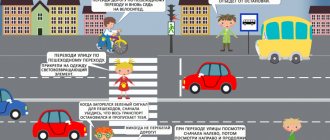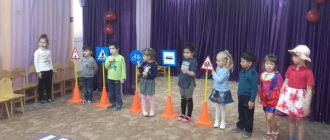MAGAZINE Preschooler.RF
“Children’s scientific and practical conference is an effective form of educational activity for the formation of prerequisites for the educational activities of older preschoolers”The report was prepared by:
- Maryasova Tatyana Georgievna, teacher of MBDOU "TsRR - d/s "Raduga"
- Bautina Elena Aleksandrovna, teacher of the MBDOU "CRR - d/s "Rainbow"
We would like to present to your attention the experience of our group in organizing a children's scientific and practical conference for older preschoolers.
A situation arises when first-graders have a large stock of knowledge and skills, but are not ready for educational activities. For the development of educational activity, its prerequisites must be formed in preschool age. It is for this reason that many kindergartens are focused on finding new forms and methods of work to create the prerequisites for educational activities. In our opinion, one of such promising forms is a scientific-practical conference.
In our kindergarten, the final event was a scientific and practical conference.
Topics of our conferences: “Our smaller friends” , “Indoor plants are our friends” , “Mysterious space” , etc.
Goal: creating conditions for the formation of prerequisites for educational activities through children's scientific and practical conferences.
Objectives of the Conference:
— creating conditions for self-realization for children of senior preschool age.
— creating conditions for scientific communication and developing public speaking skills.
— develop grammatically correct dialogical and monologue speech of children during the presentation of their project.
— to develop in children the ability to listen to each other and empathize.
— involve parents in the educational process of kindergarten on the basis of joint cognitive and research activities with children and teachers.
As part of the preparation, specialists and educators of the preschool educational institution drew up a scenario for the conference. Information about the date and location of the scientific and practical conference was posted in the corner for parents. The preparation of the reports was carried out by the students themselves and their parents, who received the status of scientific supervisors. They collected research material together with educators, who, as conference organizers, controlled the process of collecting abstracts for the conference.
The first conferences were a great challenge for us; we did not believe in our strengths, in the capabilities of preschoolers, we believed that this was not a form of work that was close and understandable to preschool children, and we were worried. Only active children capable of public speaking were selected to participate. Each time the participants in such conferences became more and more diverse, the children consciously carried out experiments, research and abstract reports.
Each presentation was fascinating, educational, interesting, containing facts from the life of animals, plants, and mysteries of space that were still unknown to children, to which relevant research was devoted. Parents and children used various forms of presenting messages: poetic form, question-answer, description, discussion with the audience, presentations.
Despite the fact that the time allotted for each participant to speak was 3-5 minutes, the excitement of the participants was obvious. Therefore, in order to relieve tension in the breaks between “scientific messages,” the parents of the participants conducted didactic games and relay races with their children.
During the final stage, the results of the conference were summed up. The results were summed up by the jury, which included the head of the MBDOU, the deputy head of the MBDOU and the chairman of the parent committee of the group.
Based on the results of the conference, all participants were awarded diplomas of various degrees.
Thus, the active use of this form of educational activity with preschoolers made it possible to form the prerequisites for educational activity in children. Pupils are active and inquisitive, show initiative and independence, are able to analyze, compare and generalize, and establish cause and effect relationships. Children accept the task assigned to them, think through and find not only ways of action to solve it, but also options for their implementation. Pupils subordinate their actions to the rule and know how to interact with each other.
We consider this form of teamwork to be effective and recommend using it in working with children of older preschool age and their parents.
| Next > |
My family traditions
Parent conference at the preschool educational institution.
One of the tasks of our kindergarten is to promote the development and strengthening of the family as a social institution by involving parents in cooperation and participation in raising children.
Tasks:
- promote the observance of existing family traditions and the emergence of new ones;
promote the exchange of experience in family education and traditions;- improve the pedagogical culture of parents;
- look for new forms of interaction between teachers and parents.
Materials and equipment:
A4 sheet with a family tree, pencils, scissors, silhouette of a lamb made of cardboard, glue pencil, woolen threads, napkins; musical accompaniment; threads and ribbons for games, prizes for each child; scarves for the game "Yurt".
Progress of the event
(Families are invited to the music room; each family has a separate table.)
Leading:
Dear parents! Today we have gathered to talk about family, family traditions and their importance in the upbringing and development of a preschool child. Before starting our conversation, I offer you a warm-up “What do we know about the family.”
What is the Latin word for "family". (Surname.)
Now say “family” in Italian. (Mafia.)
As you know, the Greek goddess Athena was the goddess of wisdom, and the owl was considered her bird. But the goddess Hera, the wife of Zeus, was considered the patroness of family and motherhood. Guess which bird was considered the “bird of Hera”? (Stork.)
What is the Russian “fruit” proverb about someone who has inherited bad, unseemly behavior from their father or mother? ("The apple never falls far from the tree".)
What Russian toy is this quote from the encyclopedia about: “It personifies the idea of a strong family, prosperity, procreation, and carries the idea of unity”? (About the nesting doll.)
Leading:
Dear parents!
How do you calculate who has the leading role in raising a child – the family or the kindergarten? (Answers from parents.)
The priority in raising a child undoubtedly belongs to the family.
What do you think the word “family” means? (Answers.)
For a long time, home and family have always been spoken of with love and respect. Legends, fairy tales, proverbs and sayings about family have come down to us from ancient times. Let's try to remember them.
Being a guest is good, but being at home is better).
The hut is not red in its corners, but... (red in its pies).
As it is at home, so is it... (yourself).
Children are not a burden, but... (a joy).
When the family is together and... (heart in the right place).
Leading:
The moral health of a family, its spiritual values and, consequently, its potential educational capabilities can be judged by the traditions established in it. I invite you to answer the questions now.
What do you think is included in the concept of “family traditions”?
What family traditions do you have in your family?
Do family traditions influence the upbringing of a child?
What positive character traits do they foster in a child? (Parents' answers.)
Leading:
So let's look at our traditions. One of the traditions of every family is celebrating a birthday.
child.
And what is a holiday without a gift and surprise? Now we propose to play the “Choose a Gift” game. ( A rope is stretched across the room and gifts wrapped in paper are hung on it. The child’s eyes are closed, untwisted, and he must cut off some gift with scissors.)
Presenter:
Another tradition is compiling a family tree.
We suggest now compiling a pedigree for your family. Start with your children. (Leaflets with a picture of a family tree are distributed, and the participants in the parent conference write down their pedigree, time to complete the task is 5 minutes.)
Presenter:
Who had the most numerous clan? Do you know where your parents and grandparents are from? Who came up with the name you have?
Leading:
Look, our hall is decorated with photographs from family albums. Unfortunately, in the modern computer world, this tradition is receding more and more into the background. But, however, the selection of photographs, the design of album pages is exactly the communication that a child needs in his joint activities with his parents. In addition, memorial certificates and documents about achievements can be placed in the album - a family archive.
Leading:
Another good tradition is playing with your child. Play is a child’s life, not preparation for life. There are a lot of games and toys. You should carefully and thoughtfully approach their selection.
Role-playing game:
the main type of games for preschoolers. During this game, the child tries on various social roles, puts himself in social situations that he could see in the real life of adults.
Outdoor games:
Children are very active and restless, which is why outdoor games are so important. In them, children can realize their need for movement, improve their motor skills and abilities, and develop such physical qualities as speed, agility, and strength.
Folk games:
help maintain cultural traditions and connections between generations. We invite you to play with us one of the Bashkir folk games “Yurt”.
The game involves four subgroups of children, each of which forms a circle at the corners of the site. In the center of each circle there is a chair on which a scarf with a national pattern is hung. Holding hands, everyone walks in four circles at alternating steps and sings:
We are funny guys
Let's all gather in a circle,
Let's play and dance
And let's rush to the meadow.
At the end of the music, they quickly run to their chairs, take a scarf and pull it over their heads in the form of a tent (roof), it turns out to be a yurt. The first group of children to build a yurt wins.
Leading:
Family meals are also a wonderful tradition.
You can communicate at the table on any topic - discuss news, events of the day. The benefits of family dinners together are enormous. Firstly, it is helping children acquire language. Secondly, such family dinners provide a sense of family cohesion. And, of course, a family dinner is an occasion for your favorite dishes! Now each family will share their signature dishes. (Discussion.)
And we also have our own tradition - to end any event with tea. And today we will not violate it. After all, our parents prepared sweet dishes.
Gulnara Gaffanova, teacher, Liliya Fayzullina, teacher,
Olga Nikiforova, senior teacher
MBDOU D/s No. 59 Salavat rep. Bashkortostan


